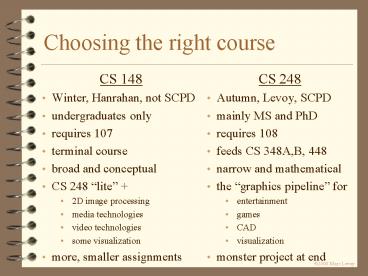Choosing the right course - PowerPoint PPT Presentation
Title:
Choosing the right course
Description:
Choosing the right course CS 148 Winter, Hanrahan, not SCPD undergraduates only requires 107 terminal course broad and conceptual CS 248 lite + – PowerPoint PPT presentation
Number of Views:87
Avg rating:3.0/5.0
Title: Choosing the right course
1
Choosing the right course
- CS 148
- Winter, Hanrahan, not SCPD
- undergraduates only
- requires 107
- terminal course
- broad and conceptual
- CS 248 lite
- 2D image processing
- media technologies
- video technologies
- some visualization
- more, smaller assignments
- CS 248
- Autumn, Levoy, SCPD
- mainly MS and PhD
- requires 108
- feeds CS 348A,B, 448
- narrow and mathematical
- the graphics pipeline for
- entertainment
- games
- CAD
- visualization
- monster project at end
2
CS 178 digital photography
- university-wide
- mainly undergraduate
- science, engineering, and art
- photography assignments and crits
- no programming experience required
- must have camera with manual shutter aperture
- Spring quarter, Tue/Thu, 215 330
3
History of computer graphics
- CS 248 - Introduction to Computer Graphics
- Autumn quarter, 2008
- Slides for September 23 lecture
4
Ivan Sutherland (1963) - SKETCHPAD
- pop-up menus
- constraint-based drawing
- hierarchical modeling
5
Display hardware
- vector displays
- 1963 modified oscilloscope
- 1974 Evans and Sutherland Picture System
- raster displays
- 1975 Evans and Sutherland frame buffer
- 1980s cheap frame buffers ? bit-mapped personal
computers - 1990s liquid-crystal displays ? laptops
- 2000s micro-mirror projectors ? digital cinema
- 2010s high dynamic range displays?
- other
- stereo, head-mounted displays
- autostereoscopic displays
6
Input hardware
- 2D
- light pen, tablet, mouse, joystick, track ball,
touch screen, etc. - 1970s 80s - CCD analog image sensor frame
grabber
7
Input hardware
- 2D
- light pen, tablet, mouse, joystick, track ball,
touch panel, etc. - 1970s 80s - CCD analog image sensor frame
grabber
8
Input hardware
- 2D
- light pen, tablet, mouse, joystick, track ball,
touch panel, etc. - 1970s 80s - CCD analog image sensor frame
grabber - 1990s 2000s - CMOS digital sensor in-camera
processing
? high-dynamic range (HDR) imaging
9
no cameras automatically take HDR pictures (How
much to bracket?)
tone mapping is still hard to do
10
Input hardware
- 2D
- light pen, tablet, mouse, joystick, track ball,
touch panel, etc. - 1970s 80s CCD analog image sensor frame
grabber - 1990s 2000s CMOS digital sensor in-camera
processing - ? high-dynamic range (HDR) imaging
- ? cell phone cameras
11
Unretouched pictures from Nokia N95(5
megapixels, Zeiss lens, auto-focus)
12
(No Transcript)
13
(No Transcript)
14
(No Transcript)
15
(No Transcript)
16
Input hardware
3mm mesh
- 2D
- light pen, tablet, mouse, joystick, track ball,
touch panel, etc. - 1970s 80s - CCD analog image sensor frame
grabber - 1990s 2000s - CMOS digital sensor in-camera
processing ? high-dynamic range (HDR) imaging - ? cell phone cameras
- 3D
- 1980s - 3D trackers
- 1990s - active rangefinders
17
Input hardware
- 2D
- light pen, tablet, mouse, joystick, track ball,
touch panel, etc. - 1970s 80s - CCD analog image sensor frame
grabber - 1990s 2000s - CMOS digital sensor in-camera
processing ? high-dynamic range (HDR) imaging - ? cell phone cameras
- 3D
- 1980s - 3D trackers
- 1990s - active rangefinders
- 4D and higher
- multiple cameras
- multi-arm gantries
18
Rendering
- 1960s - the visibility problem
- Roberts (1963), Appel (1967) - hidden-line
algorithms - Warnock (1969), Watkins (1970) - hidden-surface
algorithms - Sutherland (1974) - visibility sorting
19
- 1960s - the visibility problem
- Roberts (1963), Appel (1967) - hidden-line
algorithms - Warnock (1969), Watkins (1970) - hidden-surface
algorithms - Sutherland (1974) - visibility sorting
- 1970s - raster graphics
- Gouraud (1971) - diffuse lighting
- Phong (1974) - specular lighting
- Blinn (1974) - curved surfaces, texture
- Catmull (1974) - Z-buffer hidden-surface
algorithm - Crow (1977) - anti-aliasing
20
- 1960s - the visibility problem
- Roberts (1963), Appel (1967) - hidden-line
algorithms - Warnock (1969), Watkins (1970) - hidden-surface
algorithms - Sutherland (1974) - visibility sorting
- 1970s - raster graphics
- Gouraud (1971) - diffuse lighting
- Phong (1974) - specular lighting
- Blinn (1974) - curved surfaces, texture
- Catmull (1974) - Z-buffer hidden-surface
algorithm - Crow (1977) - anti-aliasing
21
- early 1980s - global illumination
- Whitted (1980) - ray tracing
- Goral, Torrance et al. (1984), Cohen (1985) -
radiosity - Kajiya (1986) - the rendering equation
22
- early 1980s - global illumination
- Whitted (1980) - ray tracing
- Goral, Torrance et al. (1984), Cohen (1985) -
radiosity - Kajiya (1986) - the rendering equation
- late 1980s - photorealism
- Cook (1984) - shade trees
- Perlin (1985) - shading languages
- Hanrahan and Lawson (1990) - RenderMan
? shaders
23
- early 1990s - non-photorealistic rendering
- Drebin et al. (1988), Levoy (1988) - volume
rendering - Haeberli (1990) - impressionistic paint programs
- Salesin et al. (1994-) - automatic pen-and-ink
illustration - Meier (1996) - painterly rendering
24
- early 1990s - non-photorealistic rendering
- Drebin et al. (1988), Levoy (1988) - volume
rendering - Haeberli (1990) - impressionistic paint programs
- Salesin et al. (1994-) - automatic pen-and-ink
illustration - Meier (1996) - painterly rendering
25
- early 1990s - non-photorealistic rendering
- Drebin et al. (1988), Levoy (1988) - volume
rendering - Haeberli (1990) - impressionistic paint programs
- Salesin et al. (1994-) - automatic pen-and-ink
illustration - Meier (1996) - painterly rendering
- late 1990s - image-based rendering
- Chen and Williams (1993) - view interpolation
- McMillan and Bishop (1995) - plenoptic modeling
- Levoy and Hanrahan (1996) - light field rendering































